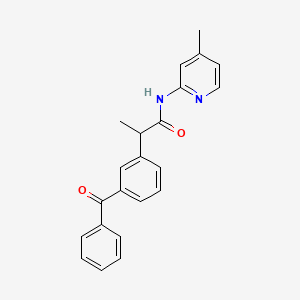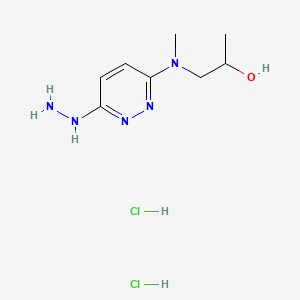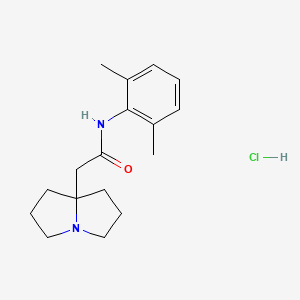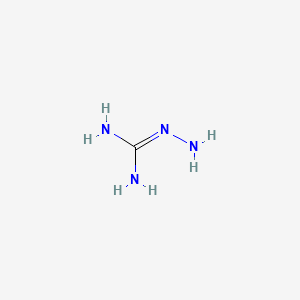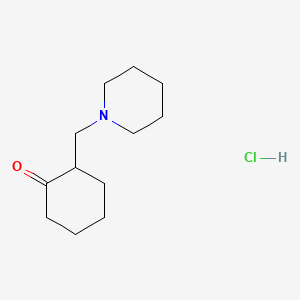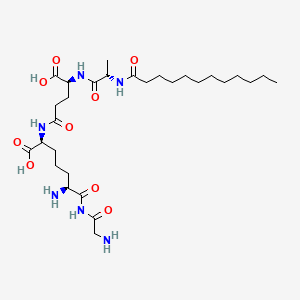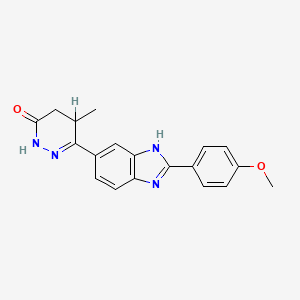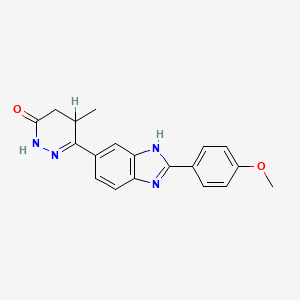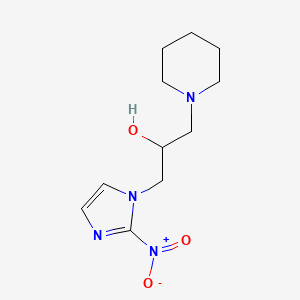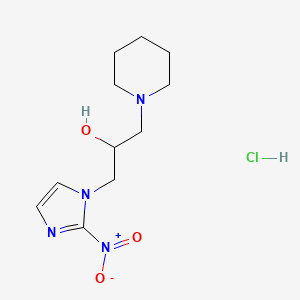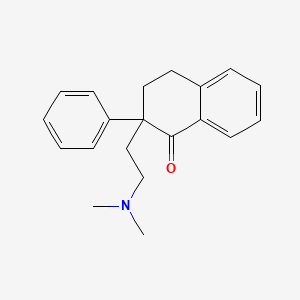
ピラセタム
概要
説明
ピラセタムは、ラセタム系に属するノオトロピック薬であり、化学名は2-オキソ-1-ピロリジンアセトアミドです。それは、神経伝達物質γ-アミノ酪酸(GABA)の環状誘導体です。ピラセタムは1971年にUCB Pharmaによって最初に販売され、認知増強作用で知られています。これは、さまざまな認知障害、めまい、皮質ミオクローヌス、失読症、鎌状赤血球貧血で使用されています .
作用機序
ピラセタムの作用機序は完全に解明されていませんが、いくつかの経路が関与していると考えられています。
神経伝達物質の調節: ピラセタムは、コリン作動性およびグルタミン酸作動性システムにおける神経伝達を調節します。
神経保護: 神経保護作用があり、神経可塑性を強化し、低酸素状態から保護します。
類似の化合物との比較
ピラセタムは、以下を含む他のラセタムと比較されることがよくあります。
オキシラセタム: 刺激作用で知られており、認知増強のために使用されます。
アニラセタム: 不安解消作用があり、不安障害や認知障害に使用されます。
プラミラセタム: ピラセタムよりも強力であり、外傷性脳損傷に関連する認知障害に使用されます。
フェニルピラセタム: より強力であり、認知増強や身体能力の向上など、より幅広い適応症に使用されます .
ピラセタムは、その安全性の高いプロファイルと幅広い用途で独特であり、研究と臨床の両方において汎用性の高い化合物となっています。
科学的研究の応用
Piracetam has a wide range of scientific research applications:
Chemistry: Used as a model compound for studying the properties of cyclic amides and their derivatives.
Biology: Investigated for its effects on cell membrane fluidity and neuroprotection.
Medicine: Used in the treatment of cognitive disorders, myoclonus, and sickle cell anemia. It has also been studied for its potential benefits in conditions like dementia, vertigo, and dyslexia.
Industry: Utilized in the development of nootropic supplements and cognitive enhancers .
生化学分析
Biochemical Properties
Piracetam interacts with various enzymes, proteins, and other biomolecules. It shares the same 2-oxo-pyrrolidone base structure with pyroglutamic acid and is a cyclic derivative of the neurotransmitter γ-aminobutyric acid (GABA) . Its mechanism of action differs from that of endogenous GABA . Piracetam has neuroprotective and anticonvulsant properties and is reported to improve neural plasticity .
Cellular Effects
Piracetam has significant effects on various types of cells and cellular processes. It enhances the growth of cells, inhibits oxidative stress, and improves mitochondrial function . It influences cell function by modulating neurotransmission in a range of transmitter systems, including cholinergic and glutamatergic systems .
Molecular Mechanism
Piracetam exerts its effects at the molecular level through various mechanisms. It influences neuronal and vascular functions by restoring cell membrane fluidity . This mechanism of action is thought to improve membrane stability, allowing the membrane and transmembrane proteins to maintain and recover the three-dimensional structure or folding for normal function .
Temporal Effects in Laboratory Settings
Piracetam shows changes in its effects over time in laboratory settings. It has been observed that piracetam increases regional cerebral blood flow . This suggests that piracetam might have long-term effects on cellular function observed in in vitro or in vivo studies .
Dosage Effects in Animal Models
The effects of piracetam vary with different dosages in animal models. For instance, daily piracetam treatment at doses of 0, 75, 150, and 300 mg/kg ip was initiated in 6-week-old male mice. The study found that low doses of piracetam reduced search time in the visible-platform component, while all piracetam doses prevented trial-related improvements in performance .
Metabolic Pathways
Piracetam is involved in various metabolic pathways. It has been shown to alter the physical properties of the plasma membrane by increasing its fluidity and protecting the cell against hypoxia . It also increases red cell deformability and normalizes the aggregation of hyperactive platelets .
Transport and Distribution
Piracetam is transported and distributed within cells and tissues. After oral ingestion, piracetam is rapidly absorbed with a bioavailability of 100%. Its volume of distribution is 0.6 L/kg and plasma protein binding is 0% .
Subcellular Localization
It is known that piracetam influences neuronal and vascular functions by restoring cell membrane fluidity . This suggests that piracetam might have specific targeting signals or post-translational modifications that direct it to specific compartments or organelles.
準備方法
合成経路と反応条件
ピラセタムは、いくつかの方法で合成できます。一般的な方法の1つは、塩基の存在下で2-ピロリドンをクロロ酢酸エチルと反応させ、続いて加水分解してピラセタムを得る方法です。別の方法は、γ-アミノ酪酸(GABA)を無水酢酸と環化させる方法です .
工業生産方法
ピラセタムの工業生産では、通常、前述の方法を用いた大規模合成が行われます。このプロセスは、高収率と高純度を実現するように最適化されており、最終製品が医薬品の基準を満たすことが保証されています。生産プロセスには、純粋な化合物を得るための結晶化、ろ過、乾燥などの工程が含まれます .
化学反応の分析
反応の種類
ピラセタムは、以下を含むさまざまな化学反応を受けます。
酸化: ピラセタムは酸化されて2-ピロリドン-5-カルボン酸を生成します。
還元: ピラセタムの還元により、2-ピロリドンが生成されます。
一般的な試薬と条件
酸化: 一般的な酸化剤には、過マンガン酸カリウムや過酸化水素などがあります。
還元: 水素化リチウムアルミニウムなどの還元剤を使用できます。
生成される主な生成物
酸化: 2-ピロリドン-5-カルボン酸
還元: 2-ピロリドン
置換: さまざまなアセトアミド誘導体
科学研究における用途
ピラセタムは、幅広い科学研究用途を持っています。
化学: 環状アミドとその誘導体の特性を研究するためのモデル化合物として使用されます。
生物学: 細胞膜の流動性と神経保護に対する影響が調査されています。
医学: 認知障害、ミオクローヌス、鎌状赤血球貧血の治療に使用されます。認知症、めまい、失読症などの症状に対する潜在的な利点についても研究されています。
類似化合物との比較
Piracetam is often compared with other racetams, including:
Oxiracetam: Known for its stimulating effects and used for cognitive enhancement.
Aniracetam: Has anxiolytic properties and is used for anxiety and cognitive disorders.
Pramiracetam: More potent than piracetam, used for cognitive deficits associated with traumatic brain injuries.
Phenylpiracetam: More potent and used for a wider range of indications, including cognitive enhancement and physical performance .
Piracetam is unique in its well-documented safety profile and broad range of applications, making it a versatile compound in both research and clinical settings.
特性
IUPAC Name |
2-(2-oxopyrrolidin-1-yl)acetamide | |
|---|---|---|
| Source | PubChem | |
| URL | https://pubchem.ncbi.nlm.nih.gov | |
| Description | Data deposited in or computed by PubChem | |
InChI |
InChI=1S/C6H10N2O2/c7-5(9)4-8-3-1-2-6(8)10/h1-4H2,(H2,7,9) | |
| Source | PubChem | |
| URL | https://pubchem.ncbi.nlm.nih.gov | |
| Description | Data deposited in or computed by PubChem | |
InChI Key |
GMZVRMREEHBGGF-UHFFFAOYSA-N | |
| Source | PubChem | |
| URL | https://pubchem.ncbi.nlm.nih.gov | |
| Description | Data deposited in or computed by PubChem | |
Canonical SMILES |
C1CC(=O)N(C1)CC(=O)N | |
| Source | PubChem | |
| URL | https://pubchem.ncbi.nlm.nih.gov | |
| Description | Data deposited in or computed by PubChem | |
Molecular Formula |
C6H10N2O2 | |
| Source | PubChem | |
| URL | https://pubchem.ncbi.nlm.nih.gov | |
| Description | Data deposited in or computed by PubChem | |
DSSTOX Substance ID |
DTXSID5044491 | |
| Record name | 2-Oxo-1-Pyrrolidineacetamide | |
| Source | EPA DSSTox | |
| URL | https://comptox.epa.gov/dashboard/DTXSID5044491 | |
| Description | DSSTox provides a high quality public chemistry resource for supporting improved predictive toxicology. | |
Molecular Weight |
142.16 g/mol | |
| Source | PubChem | |
| URL | https://pubchem.ncbi.nlm.nih.gov | |
| Description | Data deposited in or computed by PubChem | |
Boiling Point |
Decomposes | |
| Record name | Piracetam | |
| Source | DrugBank | |
| URL | https://www.drugbank.ca/drugs/DB09210 | |
| Description | The DrugBank database is a unique bioinformatics and cheminformatics resource that combines detailed drug (i.e. chemical, pharmacological and pharmaceutical) data with comprehensive drug target (i.e. sequence, structure, and pathway) information. | |
| Explanation | Creative Common's Attribution-NonCommercial 4.0 International License (http://creativecommons.org/licenses/by-nc/4.0/legalcode) | |
Mechanism of Action |
Piracetam interacts with the polar heads in the phospholipids membrane and the resulting mobile drug-lipid complexes are thought to reorganize the lipids and influence membrane function and fluidity. Such interaction has been reported in a study that investigated the effects of neuronal outgrowth induced by beta amyloid peptides; while amyloid peptides cause lipid disorganization within the cell membranes leading to neuronal death, piracetam demonstrated to decrease the destabilizing effects of amyloid peptide. The authors suggest that piracetam induces a positive curvature of the membrane by occupying the polar groups in the phospholipids to counteract the negative curvature induced by amyloid peptides , which in turn would decrease the likelihood of membrane fusion. This mechanism of action is thought to improve membrane stability, allowing the membrane and transmembrane proteins to maintain and recover the three-dimensional structure or folding for normal function such as membrane transport, chemical secretion, and receptor binding and stimulation. Through restored membrane fluidity, piracetam promotes restored neurotransmission such as glutamatergic and cholinergic systems, enhances neuroplasticity and mediates neuroprotective and anticonvulsant effects at the neuronal level. It is also demonstrated that piracetam also improves the fluidity of platelet membranes. At the vascular level, piracetam decreases adhesion of erythrocytes to cell wall and reduces vasospasm which in turn improves microcirculation including cerebral and renal blood flow., It was found that a drug of the nootropic nature piracetam possessing pronounced antihypoxic properties eliminates calcium chloride-induced disturbances of the cardiac rhythm and significantly raises the threshold of atrial fibrillation during electrical stimulation. The drug's antiarrhythmic effect is followed by a decrease of the rhythm rate and an increase of the contraction amplitude. The animals treated with piracetam in a dose when its antiarrhythmic effects (300 mg/kg) exhibited a decrease of the membrane potential of erythrocytes as compared with control. Similar effects occurred in the animals treated with lidocaine. It can be concluded that in certain types of arrhythmias the use of piracetam restores the normal rhythm of contractions that is perhaps connected with its positive influence on metabolic processes in the myocardium. | |
| Record name | Piracetam | |
| Source | DrugBank | |
| URL | https://www.drugbank.ca/drugs/DB09210 | |
| Description | The DrugBank database is a unique bioinformatics and cheminformatics resource that combines detailed drug (i.e. chemical, pharmacological and pharmaceutical) data with comprehensive drug target (i.e. sequence, structure, and pathway) information. | |
| Explanation | Creative Common's Attribution-NonCommercial 4.0 International License (http://creativecommons.org/licenses/by-nc/4.0/legalcode) | |
| Record name | PIRACETAM | |
| Source | Hazardous Substances Data Bank (HSDB) | |
| URL | https://pubchem.ncbi.nlm.nih.gov/source/hsdb/7529 | |
| Description | The Hazardous Substances Data Bank (HSDB) is a toxicology database that focuses on the toxicology of potentially hazardous chemicals. It provides information on human exposure, industrial hygiene, emergency handling procedures, environmental fate, regulatory requirements, nanomaterials, and related areas. The information in HSDB has been assessed by a Scientific Review Panel. | |
Color/Form |
Crystals from isopropanol | |
CAS No. |
7491-74-9 | |
| Record name | Piracetam | |
| Source | CAS Common Chemistry | |
| URL | https://commonchemistry.cas.org/detail?cas_rn=7491-74-9 | |
| Description | CAS Common Chemistry is an open community resource for accessing chemical information. Nearly 500,000 chemical substances from CAS REGISTRY cover areas of community interest, including common and frequently regulated chemicals, and those relevant to high school and undergraduate chemistry classes. This chemical information, curated by our expert scientists, is provided in alignment with our mission as a division of the American Chemical Society. | |
| Explanation | The data from CAS Common Chemistry is provided under a CC-BY-NC 4.0 license, unless otherwise stated. | |
| Record name | Piracetam [USAN:INN:BAN] | |
| Source | ChemIDplus | |
| URL | https://pubchem.ncbi.nlm.nih.gov/substance/?source=chemidplus&sourceid=0007491749 | |
| Description | ChemIDplus is a free, web search system that provides access to the structure and nomenclature authority files used for the identification of chemical substances cited in National Library of Medicine (NLM) databases, including the TOXNET system. | |
| Record name | Piracetam | |
| Source | DrugBank | |
| URL | https://www.drugbank.ca/drugs/DB09210 | |
| Description | The DrugBank database is a unique bioinformatics and cheminformatics resource that combines detailed drug (i.e. chemical, pharmacological and pharmaceutical) data with comprehensive drug target (i.e. sequence, structure, and pathway) information. | |
| Explanation | Creative Common's Attribution-NonCommercial 4.0 International License (http://creativecommons.org/licenses/by-nc/4.0/legalcode) | |
| Record name | piracetam | |
| Source | DTP/NCI | |
| URL | https://dtp.cancer.gov/dtpstandard/servlet/dwindex?searchtype=NSC&outputformat=html&searchlist=758191 | |
| Description | The NCI Development Therapeutics Program (DTP) provides services and resources to the academic and private-sector research communities worldwide to facilitate the discovery and development of new cancer therapeutic agents. | |
| Explanation | Unless otherwise indicated, all text within NCI products is free of copyright and may be reused without our permission. Credit the National Cancer Institute as the source. | |
| Record name | 2-Oxo-1-Pyrrolidineacetamide | |
| Source | EPA DSSTox | |
| URL | https://comptox.epa.gov/dashboard/DTXSID5044491 | |
| Description | DSSTox provides a high quality public chemistry resource for supporting improved predictive toxicology. | |
| Record name | Piracetam | |
| Source | European Chemicals Agency (ECHA) | |
| URL | https://echa.europa.eu/substance-information/-/substanceinfo/100.028.466 | |
| Description | The European Chemicals Agency (ECHA) is an agency of the European Union which is the driving force among regulatory authorities in implementing the EU's groundbreaking chemicals legislation for the benefit of human health and the environment as well as for innovation and competitiveness. | |
| Explanation | Use of the information, documents and data from the ECHA website is subject to the terms and conditions of this Legal Notice, and subject to other binding limitations provided for under applicable law, the information, documents and data made available on the ECHA website may be reproduced, distributed and/or used, totally or in part, for non-commercial purposes provided that ECHA is acknowledged as the source: "Source: European Chemicals Agency, http://echa.europa.eu/". Such acknowledgement must be included in each copy of the material. ECHA permits and encourages organisations and individuals to create links to the ECHA website under the following cumulative conditions: Links can only be made to webpages that provide a link to the Legal Notice page. | |
| Record name | PIRACETAM | |
| Source | FDA Global Substance Registration System (GSRS) | |
| URL | https://gsrs.ncats.nih.gov/ginas/app/beta/substances/ZH516LNZ10 | |
| Description | The FDA Global Substance Registration System (GSRS) enables the efficient and accurate exchange of information on what substances are in regulated products. Instead of relying on names, which vary across regulatory domains, countries, and regions, the GSRS knowledge base makes it possible for substances to be defined by standardized, scientific descriptions. | |
| Explanation | Unless otherwise noted, the contents of the FDA website (www.fda.gov), both text and graphics, are not copyrighted. They are in the public domain and may be republished, reprinted and otherwise used freely by anyone without the need to obtain permission from FDA. Credit to the U.S. Food and Drug Administration as the source is appreciated but not required. | |
| Record name | PIRACETAM | |
| Source | Hazardous Substances Data Bank (HSDB) | |
| URL | https://pubchem.ncbi.nlm.nih.gov/source/hsdb/7529 | |
| Description | The Hazardous Substances Data Bank (HSDB) is a toxicology database that focuses on the toxicology of potentially hazardous chemicals. It provides information on human exposure, industrial hygiene, emergency handling procedures, environmental fate, regulatory requirements, nanomaterials, and related areas. The information in HSDB has been assessed by a Scientific Review Panel. | |
Melting Point |
151.5 - 152.5 °C | |
| Record name | Piracetam | |
| Source | DrugBank | |
| URL | https://www.drugbank.ca/drugs/DB09210 | |
| Description | The DrugBank database is a unique bioinformatics and cheminformatics resource that combines detailed drug (i.e. chemical, pharmacological and pharmaceutical) data with comprehensive drug target (i.e. sequence, structure, and pathway) information. | |
| Explanation | Creative Common's Attribution-NonCommercial 4.0 International License (http://creativecommons.org/licenses/by-nc/4.0/legalcode) | |
| Record name | PIRACETAM | |
| Source | Hazardous Substances Data Bank (HSDB) | |
| URL | https://pubchem.ncbi.nlm.nih.gov/source/hsdb/7529 | |
| Description | The Hazardous Substances Data Bank (HSDB) is a toxicology database that focuses on the toxicology of potentially hazardous chemicals. It provides information on human exposure, industrial hygiene, emergency handling procedures, environmental fate, regulatory requirements, nanomaterials, and related areas. The information in HSDB has been assessed by a Scientific Review Panel. | |
Retrosynthesis Analysis
AI-Powered Synthesis Planning: Our tool employs the Template_relevance Pistachio, Template_relevance Bkms_metabolic, Template_relevance Pistachio_ringbreaker, Template_relevance Reaxys, Template_relevance Reaxys_biocatalysis model, leveraging a vast database of chemical reactions to predict feasible synthetic routes.
One-Step Synthesis Focus: Specifically designed for one-step synthesis, it provides concise and direct routes for your target compounds, streamlining the synthesis process.
Accurate Predictions: Utilizing the extensive PISTACHIO, BKMS_METABOLIC, PISTACHIO_RINGBREAKER, REAXYS, REAXYS_BIOCATALYSIS database, our tool offers high-accuracy predictions, reflecting the latest in chemical research and data.
Strategy Settings
| Precursor scoring | Relevance Heuristic |
|---|---|
| Min. plausibility | 0.01 |
| Model | Template_relevance |
| Template Set | Pistachio/Bkms_metabolic/Pistachio_ringbreaker/Reaxys/Reaxys_biocatalysis |
| Top-N result to add to graph | 6 |
Feasible Synthetic Routes
試験管内研究製品の免責事項と情報
BenchChemで提示されるすべての記事および製品情報は、情報提供を目的としています。BenchChemで購入可能な製品は、生体外研究のために特別に設計されています。生体外研究は、ラテン語の "in glass" に由来し、生物体の外で行われる実験を指します。これらの製品は医薬品または薬として分類されておらず、FDAから任何の医療状態、病気、または疾患の予防、治療、または治癒のために承認されていません。これらの製品を人間または動物に体内に導入する形態は、法律により厳格に禁止されています。これらのガイドラインに従うことは、研究と実験において法的および倫理的な基準の遵守を確実にするために重要です。


